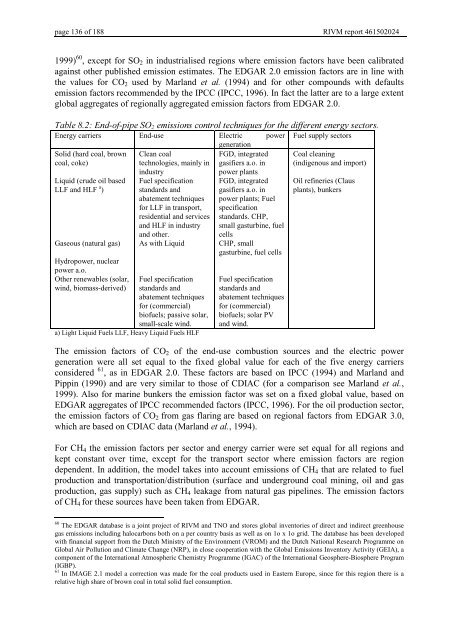Targets IMage Energy Regional (TIMER) Model, Technical ...
Targets IMage Energy Regional (TIMER) Model, Technical ...
Targets IMage Energy Regional (TIMER) Model, Technical ...
You also want an ePaper? Increase the reach of your titles
YUMPU automatically turns print PDFs into web optimized ePapers that Google loves.
page 136 of 188 RIVM report 461502024<br />
1999) 60 , except for SO 2 in industrialised regions where emission factors have been calibrated<br />
against other published emission estimates. The EDGAR 2.0 emission factors are in line with<br />
the values for CO 2 used by Marland HW DO (1994) and for other compounds with defaults<br />
emission factors recommended by the IPCC (IPCC, 1996). In fact the latter are to a large extent<br />
global aggregates of regionally aggregated emission factors from EDGAR 2.0.<br />
7DEOH(QGRISLSH62 HPLVVLRQVFRQWUROWHFKQLTXHVIRUWKHGLIIHUHQWHQHUJ\VHFWRUV<br />
<strong>Energy</strong> carriers End-use Electric power<br />
generation<br />
Solid (hard coal, brown Clean coal<br />
FGD, integrated<br />
coal, coke)<br />
technologies, mainly in gasifiers a.o. in<br />
Liquid (crude oil based<br />
LLF and HLF a )<br />
industry<br />
Fuel specification<br />
standards and<br />
abatement techniques<br />
for LLF in transport,<br />
residential and services<br />
and HLF in industry<br />
and other.<br />
power plants<br />
FGD, integrated<br />
gasifiers a.o. in<br />
power plants; Fuel<br />
specification<br />
standards. CHP,<br />
small gasturbine, fuel<br />
cells<br />
Gaseous (natural gas) As with Liquid CHP, small<br />
gasturbine, fuel cells<br />
Hydropower, nuclear<br />
power a.o.<br />
Other renewables (solar,<br />
wind, biomass-derived)<br />
Fuel specification<br />
standards and<br />
abatement techniques<br />
for (commercial)<br />
biofuels; passive solar,<br />
small-scale wind.<br />
a) Light Liquid Fuels LLF, Heavy Liquid Fuels HLF<br />
Fuel specification<br />
standards and<br />
abatement techniques<br />
for (commercial)<br />
biofuels; solar PV<br />
and wind.<br />
Fuel supply sectors<br />
Coal cleaning<br />
(indigenous and import)<br />
Oil refineries (Claus<br />
plants), bunkers<br />
The emission factors of CO 2 of the end-use combustion sources and the electric power<br />
generation were all set equal to the fixed global value for each of the five energy carriers<br />
considered 61 , as in EDGAR 2.0. These factors are based on IPCC (1994) and Marland and<br />
Pippin (1990) and are very similar to those of CDIAC (for a comparison see Marland HWDO,<br />
1999). Also for marine bunkers the emission factor was set on a fixed global value, based on<br />
EDGAR aggregates of IPCC recommended factors (IPCC, 1996). For the oil production sector,<br />
the emission factors of CO 2 from gas flaring are based on regional factors from EDGAR 3.0,<br />
which are based on CDIAC data (Marland HWDO, 1994).<br />
For CH 4 the emission factors per sector and energy carrier were set equal for all regions and<br />
kept constant over time, except for the transport sector where emission factors are region<br />
dependent. In addition, the model takes into account emissions of CH 4 that are related to fuel<br />
production and transportation/distribution (surface and underground coal mining, oil and gas<br />
production, gas supply) such as CH 4 leakage from natural gas pipelines. The emission factors<br />
of CH 4 for these sources have been taken from EDGAR.<br />
60 The EDGAR database is a joint project of RIVM and TNO and stores global inventories of direct and indirect greenhouse<br />
gas emissions including halocarbons both on a per country basis as well as on 1o x 1o grid. The database has been developed<br />
with financial support from the Dutch Ministry of the Environment (VROM) and the Dutch National Research Programme on<br />
Global Air Pollution and Climate Change (NRP), in close cooperation with the Global Emissions Inventory Activity (GEIA), a<br />
component of the International Atmospheric Chemistry Programme (IGAC) of the International Geosphere-Biosphere Program<br />
(IGBP).<br />
61 In IMAGE 2.1 model a correction was made for the coal products used in Eastern Europe, since for this region there is a<br />
relative high share of brown coal in total solid fuel consumption.
















